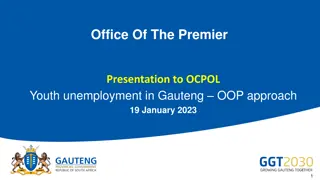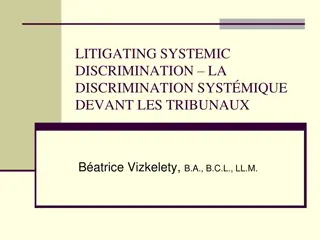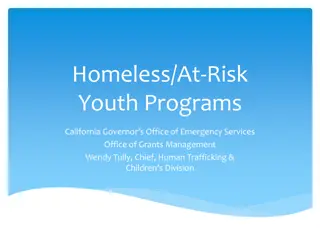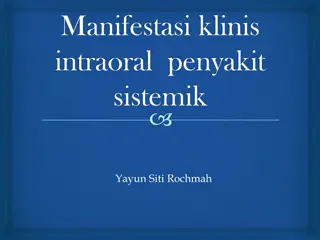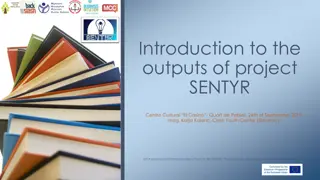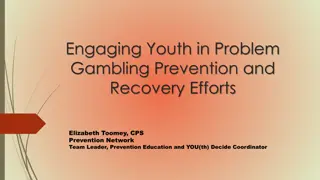Developing Systemic Changes to Support At-Risk Youth
Addressing the needs of at-risk youth requires systemic changes in various sectors such as juvenile justice, child welfare, and legal systems. Initiatives like the Dual Status Crossover Youth Practice Model aim to create collaborative case management processes. Focusing on aspects like childhood safety, stability, and nurturing relationships can have a positive impact. Developing stakeholder groups, setting goals, and educating about youth vulnerabilities are key steps towards creating a supportive environment for at-risk youth.
Download Presentation

Please find below an Image/Link to download the presentation.
The content on the website is provided AS IS for your information and personal use only. It may not be sold, licensed, or shared on other websites without obtaining consent from the author. Download presentation by click this link. If you encounter any issues during the download, it is possible that the publisher has removed the file from their server.
E N D
Presentation Transcript
DETERMINING THE WHAT Making systemic changes that support youth who are at-risk of or have crossed over October 2, 2023
Systems Change Framework DUAL STATUS CROSSOVER YOUTH PRACTICE MODEL YOUTH MODEL Developed in 2010 by Georgetown University Center for Juvenile Justice Reform Addresses improving how systems become aware of and respond to the needs of youth through creation of a collaborative case management process inclusive of Court, Child Welfare, Youth Legal System, and other youth serving systems Over 120 counties nationwide, listed as a model program by OJJDP and ranked as having promising research evidence Developed in 2014 by the Robert F. Kennedy National Resource Center for Juvenile Justice A model that supports creation or enhancement of systemic infrastructure to support dual status youth
Childhood Needs Safety: the absence of threat, neglect, and violence in which youths feel free from harm within their social and physical environments. Stability: consistency and predictability in the child s development. Nurturing: availability, sensitivity, and warmth in responding to a child s needs. Source: U.S. Department of Justice, Office of Justice Programs, Office of Juvenile Justice and Delinquency Prevention, The Prevalence of Safe, Stable, Nurturing Relationships Among Children and Adolescents, Heather A. Turner, Melissa T. Merrick, David Finkelhor, Sherry Hamby, Anne Shattuck, and Megan Henly, September 2017, accessed January 7, 2019, https://pdfs.semanticscholar.org/4a27/1685d0ea76daf7efaa5629c8ad7b111fb682.pdf.
Varying Degrees of Change Systemic Direct Services Human Behavior/Beliefs
With every interaction or transaction are you Planting Watering Uprooting
SYSTEMIC CHANGE Develop a Stakeholder Group Inclusive of youth, families, community members, courts, child welfare, and youth legal personnel Confirm your mutually agreed upon why Set time limited goals based on the why Every voice should have relevancy and power in the conversations Set the vision, mission, and goals for the work
SYSTEMIC CHANGE Educate and Create Awareness Inform colleagues about the vulnerability's youth face when in care and how it may impact them Offer training on risk factors for youth and how crossing over impacts them long-term Ensure training is offered to every person within the organization whether they work directly with youth or not Identify a play on words that will stick with people and make them THINK differently Understand that SYSTEMS aren t people, they aren t relational, and they don t serve youth well overall
SYSTEMIC CHANGE Analyze data to gain understanding What are youth and families telling you about their experience Identify the pathways youth are traveling Determine where arrests are occurring most frequently or where CPS referrals are being made from most often Data should be the driver to guide any changes
Direct Services Change Court Leading the Charge Listen to youth and families and make changes accordingly Supporting Courtroom Designs and Expectations One Judge/One Family Model Dedicated Dockets Assigned State s Attorney Designated Public Defenders
Direct Services Change Youth Legal System Listen to youth, families, and line staff to make changes accordingly Drill down into data to determine what needs change Enhance support and resources for youth and families to prevent them from needing child welfare intervention Create a strong collaborative case management process to support youth that are dually-involved case opening to case closing
Direct Services Change Child Welfare System Listen to youth, families, and line staff to make changes accordingly Drill down into data to determine what needs change Enhance support and resources for youth and families to mitigate involvement of the youth legal system Create a strong collaborative case management process to support youth that are dually-involved case opening to case closing
Human Behavior/Beliefs What we believe about a person impacts how we treat them Connect with the humanness of each youth/family you support Have empathy and compassion Identify what can be done to support them having normal childhood/adolescent experiences








